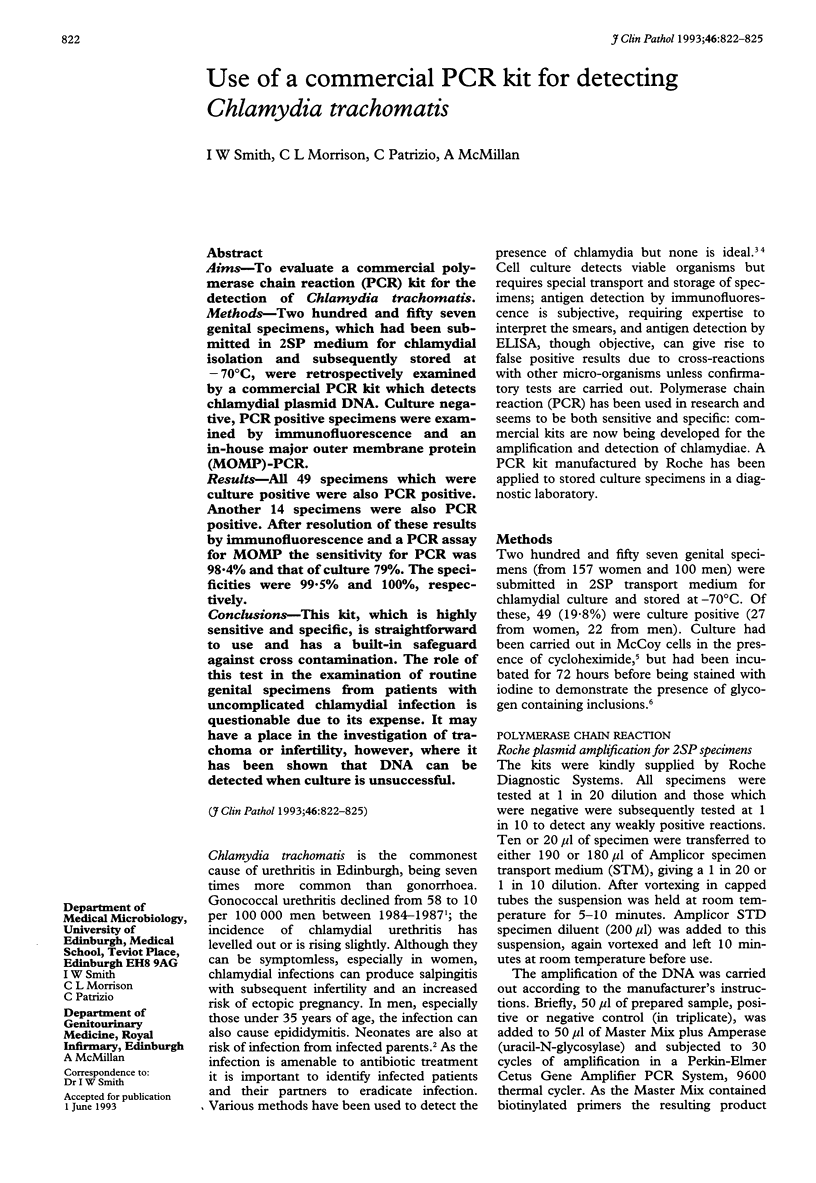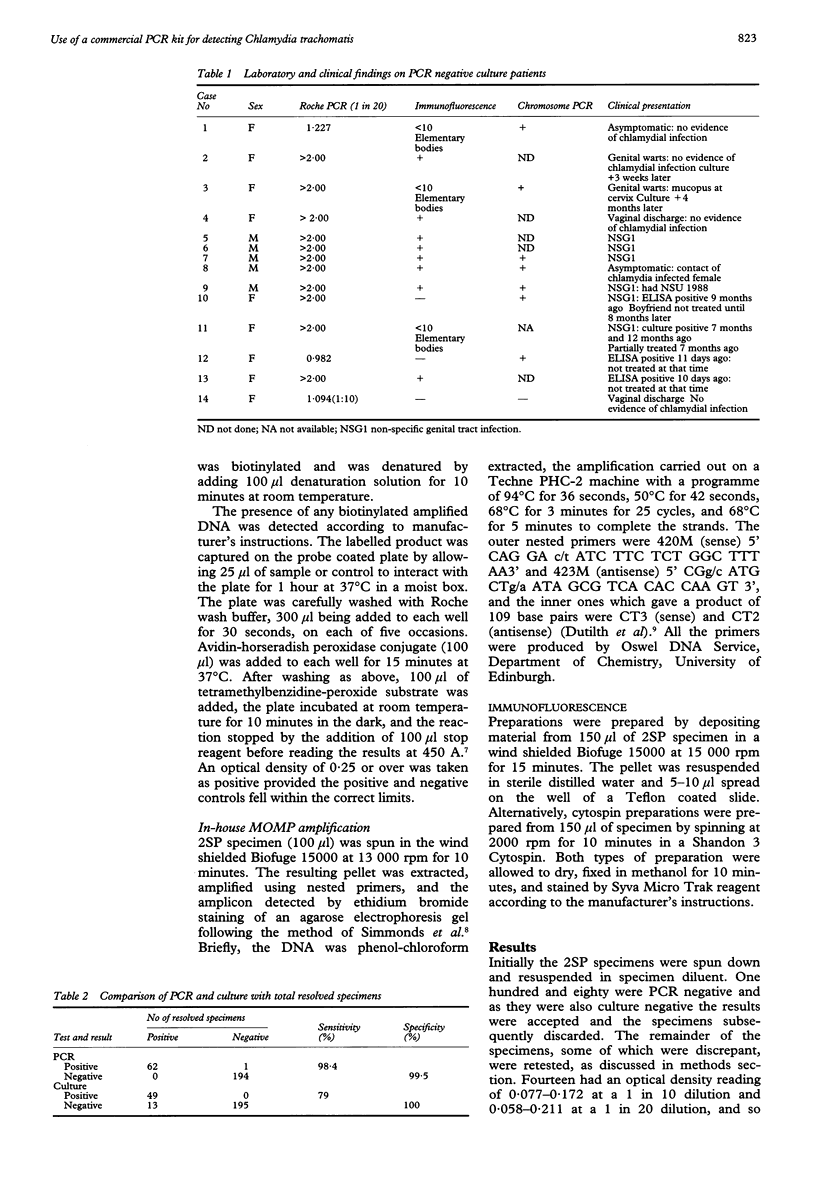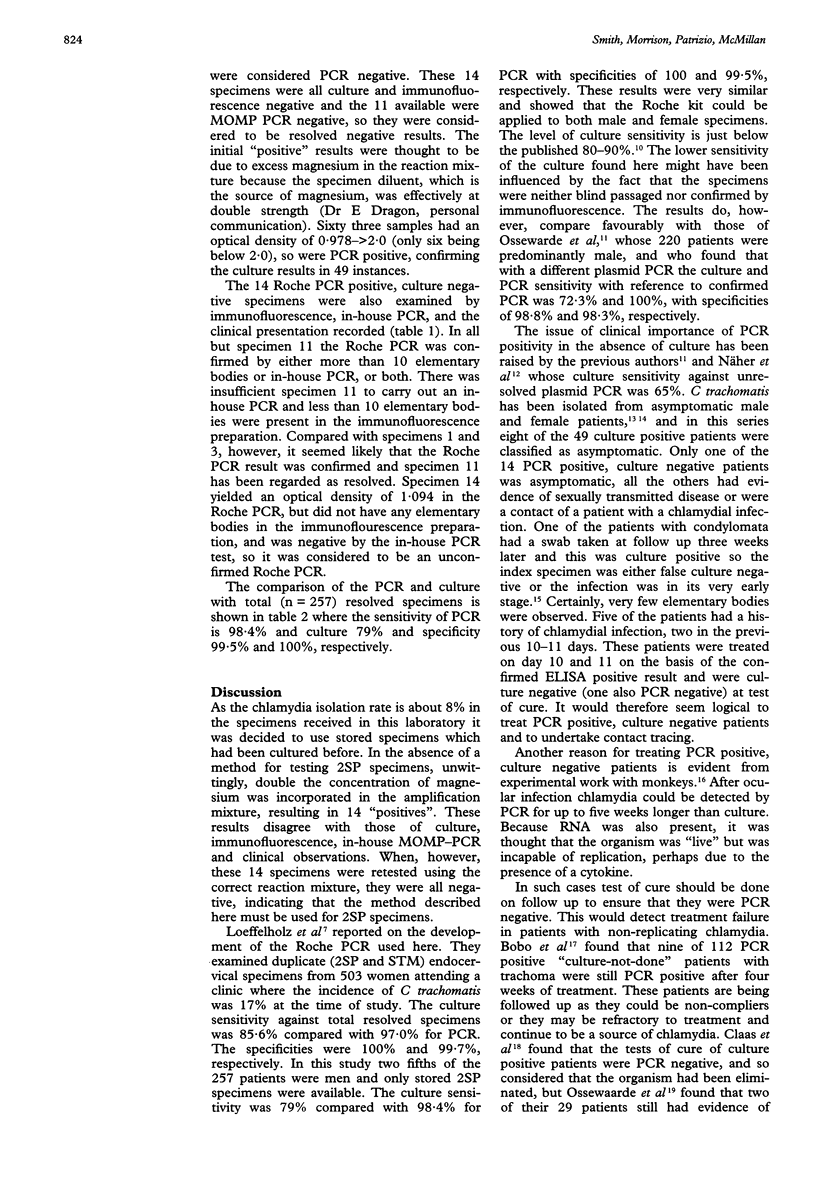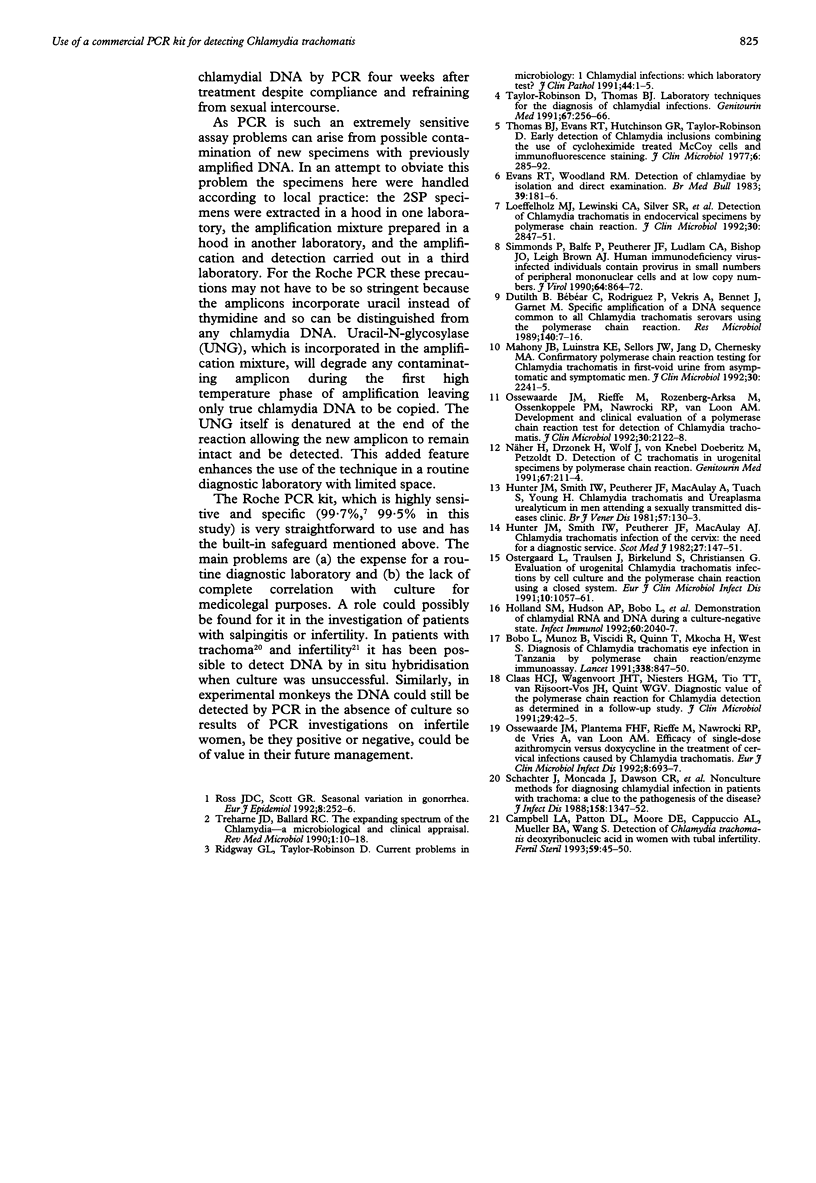Abstract
AIMS--To evaluate a commercial polymerase chain reaction (PCR) kit for the detection of Chlamydia trachomatis. METHODS--Two hundred and fifty seven genital specimens, which had been submitted in 2SP medium for chlamydial isolation and subsequently stored at -70 degrees C, were retrospectively examined by a commercial PCR kit which detects chlamydial plasmid DNA. Culture negative, PCR positive specimens were examined by immunofluorescence and an in-house major outer membrane protein (MOMP)-PCR. RESULTS--All 49 specimens which were culture positive were also PCR positive. Another 14 specimens were also PCR positive. After resolution of these results by immunofluorescence and a PCR assay for MOMP the sensitivity for PCR was 98.4% and that of culture 79%. The specificities were 99.5% and 100%, respectively. CONCLUSIONS--This kit, which is highly sensitive and specific, is straightforward to use and has a built-in safeguard against cross contamination. The role of this test in the examination of routine genital specimens from patients with uncomplicated chlamydial infection is questionable due to its expense. It may have a place in the investigation of trachoma or infertility, however, where it has been shown that DNA can be detected when culture is unsuccessful.
Full text
PDF



Selected References
These references are in PubMed. This may not be the complete list of references from this article.
- Bobo L., Munoz B., Viscidi R., Quinn T., Mkocha H., West S. Diagnosis of Chlamydia trachomatis eye infection in Tanzania by polymerase chain reaction/enzyme immunoassay. Lancet. 1991 Oct 5;338(8771):847–850. doi: 10.1016/0140-6736(91)91502-l. [DOI] [PubMed] [Google Scholar]
- Campbell L. A., Patton D. L., Moore D. E., Cappuccio A. L., Mueller B. A., Wang S. P. Detection of Chlamydia trachomatis deoxyribonucleic acid in women with tubal infertility. Fertil Steril. 1993 Jan;59(1):45–50. [PubMed] [Google Scholar]
- Claas H. C., Wagenvoort J. H., Niesters H. G., Tio T. T., Van Rijsoort-Vos J. H., Quint W. G. Diagnostic value of the polymerase chain reaction for Chlamydia detection as determined in a follow-up study. J Clin Microbiol. 1991 Jan;29(1):42–45. doi: 10.1128/jcm.29.1.42-45.1991. [DOI] [PMC free article] [PubMed] [Google Scholar]
- Dutilh B., Bébéar C., Rodriguez P., Vekris A., Bonnet J., Garret M. Specific amplification of a DNA sequence common to all Chlamydia trachomatis serovars using the polymerase chain reaction. Res Microbiol. 1989 Jan;140(1):7–16. doi: 10.1016/0923-2508(89)90053-3. [DOI] [PubMed] [Google Scholar]
- Evans R. T., Woodland R. M. Detection of chlamydiae by isolation and direct examination. Br Med Bull. 1983 Apr;39(2):181–186. doi: 10.1093/oxfordjournals.bmb.a071813. [DOI] [PubMed] [Google Scholar]
- Holland S. M., Hudson A. P., Bobo L., Whittum-Hudson J. A., Viscidi R. P., Quinn T. C., Taylor H. R. Demonstration of chlamydial RNA and DNA during a culture-negative state. Infect Immun. 1992 May;60(5):2040–2047. doi: 10.1128/iai.60.5.2040-2047.1992. [DOI] [PMC free article] [PubMed] [Google Scholar]
- Hunter J. M., Smith I. W., Peutherer J. F., MacAulay A. J. Chlamydia trachomatis infection of the cervix: the need for a diagnostic service. Scott Med J. 1982 Apr;27(2):147–151. doi: 10.1177/003693308202700207. [DOI] [PubMed] [Google Scholar]
- Hunter J. M., Smith I. W., Peutherer J. F., MacAulay A., Tuach S., Young H. Chlamydia trachomatis and Ureaplasma urealyticum in men attending a sexually transmitted diseases clinic. Br J Vener Dis. 1981 Apr;57(2):130–133. doi: 10.1136/sti.57.2.130. [DOI] [PMC free article] [PubMed] [Google Scholar]
- Loeffelholz M. J., Lewinski C. A., Silver S. R., Purohit A. P., Herman S. A., Buonagurio D. A., Dragon E. A. Detection of Chlamydia trachomatis in endocervical specimens by polymerase chain reaction. J Clin Microbiol. 1992 Nov;30(11):2847–2851. doi: 10.1128/jcm.30.11.2847-2851.1992. [DOI] [PMC free article] [PubMed] [Google Scholar]
- Mahony J. B., Luinstra K. E., Sellors J. W., Jang D., Chernesky M. A. Confirmatory polymerase chain reaction testing for Chlamydia trachomatis in first-void urine from asymptomatic and symptomatic men. J Clin Microbiol. 1992 Sep;30(9):2241–2245. doi: 10.1128/jcm.30.9.2241-2245.1992. [DOI] [PMC free article] [PubMed] [Google Scholar]
- Näher H., Drzonek H., Wolf J., von Knebel Doeberitz M., Petzoldt D. Detection of C trachomatis in urogenital specimens by polymerase chain reaction. Genitourin Med. 1991 Jun;67(3):211–214. doi: 10.1136/sti.67.3.211. [DOI] [PMC free article] [PubMed] [Google Scholar]
- Ossewaarde J. M., Plantema F. H., Rieffe M., Nawrocki R. P., de Vries A., van Loon A. M. Efficacy of single-dose azithromycin versus doxycycline in the treatment of cervical infections caused by Chlamydia trachomatis. Eur J Clin Microbiol Infect Dis. 1992 Aug;11(8):693–697. doi: 10.1007/BF01989972. [DOI] [PubMed] [Google Scholar]
- Ossewaarde J. M., Rieffe M., Rozenberg-Arska M., Ossenkoppele P. M., Nawrocki R. P., van Loon A. M. Development and clinical evaluation of a polymerase chain reaction test for detection of Chlamydia trachomatis. J Clin Microbiol. 1992 Aug;30(8):2122–2128. doi: 10.1128/jcm.30.8.2122-2128.1992. [DOI] [PMC free article] [PubMed] [Google Scholar]
- Ostergaard L., Traulsen J., Birkelund S., Christiansen G. Evaluation of urogenital Chlamydia trachomatis infections by cell culture and the polymerase chain reaction using a closed system. Eur J Clin Microbiol Infect Dis. 1991 Dec;10(12):1057–1061. doi: 10.1007/BF01984929. [DOI] [PubMed] [Google Scholar]
- Ross J. D., Scott G. R. Seasonal variation in gonorrhoea. Eur J Epidemiol. 1992 Mar;8(2):252–255. doi: 10.1007/BF00144809. [DOI] [PubMed] [Google Scholar]
- Schachter J., Moncada J., Dawson C. R., Sheppard J., Courtright P., Said M. E., Zaki S., Hafez S. F., Lorincz A. Nonculture methods for diagnosing chlamydial infection in patients with trachoma: a clue to the pathogenesis of the disease? J Infect Dis. 1988 Dec;158(6):1347–1352. doi: 10.1093/infdis/158.6.1347. [DOI] [PubMed] [Google Scholar]
- Simmonds P., Balfe P., Peutherer J. F., Ludlam C. A., Bishop J. O., Brown A. J. Human immunodeficiency virus-infected individuals contain provirus in small numbers of peripheral mononuclear cells and at low copy numbers. J Virol. 1990 Feb;64(2):864–872. doi: 10.1128/jvi.64.2.864-872.1990. [DOI] [PMC free article] [PubMed] [Google Scholar]
- Taylor-Robinson D., Thomas B. J. Laboratory techniques for the diagnosis of chlamydial infections. Genitourin Med. 1991 Jun;67(3):256–266. doi: 10.1136/sti.67.3.256. [DOI] [PMC free article] [PubMed] [Google Scholar]
- Thomas B. J., Evans R. T., Hutchinson G. R., Taylor-Robinson D. Early detection of chlamydial inclusions combining the use of cycloheximide-treated McCoy cells and immunofluorescence staining. J Clin Microbiol. 1977 Sep;6(3):285–292. doi: 10.1128/jcm.6.3.285-292.1977. [DOI] [PMC free article] [PubMed] [Google Scholar]


